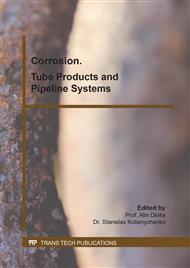[1]
W.D. Yang, Reactor Material Science, Atomic Energy Press, Beijing, (2000).
Google Scholar
[2]
U.S. Nuclear Regulatory Commission, Guidelines for evaluation fatigue analyses incorporating the life reduction of metal components due to the effects of the light-water reactor environment for new reactors, RG1.207 guideline, (2007).
Google Scholar
[3]
C.G. Lin, Passive Safety Advanced NPP AP1000, Atomic Energy Press, Beijing, (2008).
Google Scholar
[4]
J.B. Tan, X.Q. Wu, E.H. Han, W. Ke, X. Wang, H.T. Sun, Strain-rate dependent fatigue behavior of 316LN stainless steel in high-temperature water, J. Nucl. Mater. 489 (2017) 33-41.
DOI: 10.1016/j.jnucmat.2017.03.040
Google Scholar
[5]
O.K. Chopra, W. J. Shack, Effect of LWR coolant environments on the fatigue life of reactor materials, Argonne National Laboratory Report, NUREG/CR-6909, (2006).
DOI: 10.1115/pvp2006-icpvt-11-93889
Google Scholar
[6]
H.C. Wu, B. Yang, S.L. Wang, M. X. Zhang, Effect of oxidation behavior on the corrosion fatigue crack initiation and propagation of 316LN austenitic stainless steel in high temperature water, Mater. Sci. Eng, A 633 (2015) 176-183.
DOI: 10.1016/j.msea.2015.03.026
Google Scholar
[7]
O.K. Chopra, Y. Garud, G. Stevens, Update of NUREGCR 6909 methodology for environmentally assisted fatigue revised Fen expressions, ASME Code Meetings, Section III Subgroup on Fatigue Strength (Tennessee), (2012).
Google Scholar
[8]
H. Cho, B.K. Kim, I.S. Kim, C. Jang, Low cycle fatigue behaviors of type 316LN austenitic stainless steel in 310°C de-aerated water-fatigue life and dislocation structure development, Mater. Sci. Eng, A 476 (2008) 248-256.
DOI: 10.1016/j.msea.2007.07.023
Google Scholar
[9]
Chinese National Standard, Metallic materials - Fatigue testing - Axial strain-controlled method, GBT 26077, (2010).
Google Scholar
[10]
Y.L. Guo, E.H. Han, J.Q. Wang, Effects of forging and heat treatments on the microstructure and oxidation behavior of 316LN stainless steel in high temperature water, J. Mater. Sci. Technol. 31 (2015) 403-412.
DOI: 10.1016/j.jmst.2014.08.014
Google Scholar
[11]
S. Xu, X.Q. Wu, E.H. Han, W. Ke, Y. Katada, Crack initiation mechanisms for low cycle fatigue of type 316Ti stainless steel in high temperature water, Mater. Sci. Eng, A 490 (2008) 16-25.
DOI: 10.1016/j.msea.2007.12.043
Google Scholar
[12]
H. C. Wu, Study on corrosion fatigue behaviors of primary coolant pipes of nuclear power plants, Beijing: University of Science and Technology Beijing, PhD thesis, (2015).
Google Scholar
[13]
A. Pardo, M.C. Merino, A.E. Coy, F. Viejo, R. Arrabal, Pitting corrosion behavior of austenitic stainless steels-combining effects of Mn and Mo additions, Corros. Sci. 50 (2008) 1796-1806.
DOI: 10.1016/j.corsci.2008.04.005
Google Scholar



